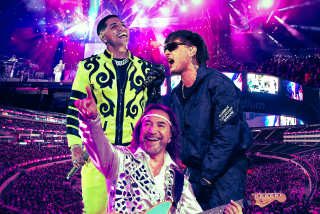A soaring show, but where was the crowd?
There’s a jazz enigma in Los Angeles. Actually, it’s one of several -- like why an area overflowing with world-class talent has not yet initiated a program remotely comparable to New York City’s Jazz at Lincoln Center. But this particular conundrum is called the Luckman Jazz Orchestra. And it is -- sometimes in actuality, sometimes in potential -- as good a large jazz ensemble as there is, anywhere.
So given this high quality, why was the Luckman Arts Center barely half-filled for Saturday night’s concert, “Love and Revolution”? Did the meager attendance have something to do with the fact that the group’s funding supports only a minimal season, that it’s difficult to build up a dedicated audience with such relatively low visibility? Has conductor James Newton’s insistence upon presenting challenging music rather than the standard fare of classic big band repertoire had a diminishing effect upon attendance?
Or is the enigma not really an enigma at all, but simply a reluctance on the part of jazz fans from the Valley, the Westside and Beverly Hills to make the trek to Luckman’s location on the campus of Cal State L.A.?
All these questions came to mind Saturday night while listening to the orchestra’s adventurous program of music, highlighted by Newton’s five-part “Suite for Elizabeth Catlett.” In this work, as in the others on the program -- especially Newton’s “Nelson Mandela” and “Shammah” and Charles Mingus’ “Duke Ellington’s Sounds of Love” -- the orchestra superbly displayed its characteristic interactivity between solos and ensemble passages.
Saxophonists Bennie Maupin and Charles Owens and trombonist Isaac Smith were the showcase improvisers, with Maupin cruising the outer limits of the avant-garde, Owens rocking through the blues and Smith ripping off passionate, instrument-scouring riffs. The ensemble passages, many orchestrated by pianist Lanny Hartley, were often edgy and dissonant, fascinatingly conceived, with an occasional lack of precision clearly reflecting inadequate rehearsal.
But the keynote was the LJO’s persistent desire to aim high, to take the large jazz ensemble instrumentation into the 21st century. It’s a noble quest, well worth making. It’s just a shame that so few of the Southland’s presumably sophisticated jazz fans were along for the ride.
More to Read
The biggest entertainment stories
Get our big stories about Hollywood, film, television, music, arts, culture and more right in your inbox as soon as they publish.
You may occasionally receive promotional content from the Los Angeles Times.










